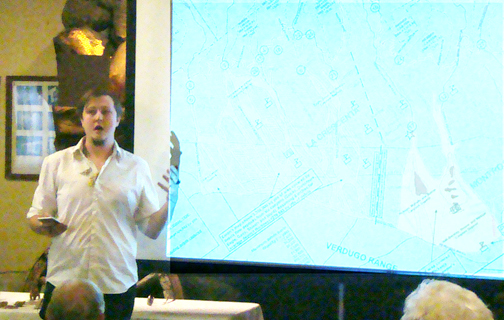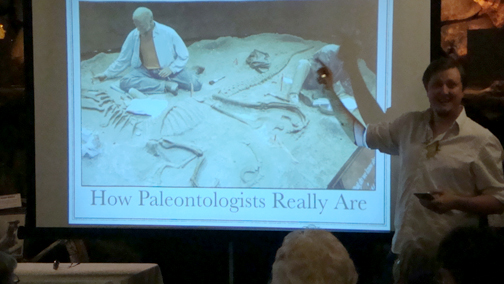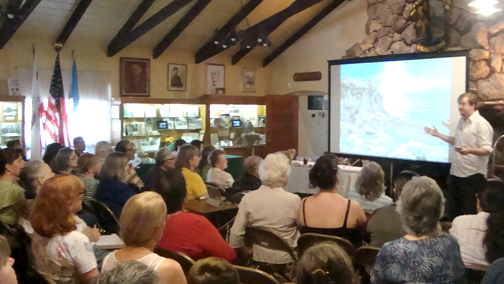
Paleontology student Charly Shelton shared the history of finds in the Crescenta Valley to a standing room only audience at Bolton Hall on Saturday.
By Jason KUROSU
The Little Landers Historical Society in Tujunga hosts regular programs at the Bolton Hall Museum covering various aspects of Tujunga history, though perhaps none quite as ancient as the presentation this past Saturday.
Shelton covered the history of the area from a paleontological perspective, describing his findings as a student and volunteer at the George C. Page Museum in Los Angeles, at the La Brea Tar Pits.
According to Shelton, the area does not offer anything in terms of dinosaur fossils as the land was still submerged beneath the Pacific Ocean, but marine animal fossils are prevalent in the surrounding mountains, including those of mollusks, clams and oysters, many of which Shelton had available for audience members to view.
Shelton noted that marine animals indeed fall under the purview of paleontologists, dispelling the misconception that paleontologists deal only with dinosaurs, rather than all animals that existed before humans.

Along with marine animals, Shelton’s studies of the nearby mountains have uncovered numerous varieties of rocks. La Crescenta’s mountains are characterized by diorite, quartz diorite, and gneiss, whereas Tujunga turns up sandstone, gypsum, and shale that can be indicative of fossils.
Rocks uncovered from the New Year’s Eve Flood of 1934 revealed some of what lies beneath the Crescenta Valley (including a mammoth tusk found by a local Boy Scout troop) and more recent incidents such as the Station Fire and additional flooding have uncovered even more.
In Deukmejian Park, Shelton and his mentor Ron Schmidtling from the Getty Museum found basalt which had been covered by debris since the Jurassic Period 200 million years ago when the mountains were part of the ocean floor.
“This has never been seen by humans and hasn’t been exposed to the sun for 200 million years. This is up in the mountains now because of what washed out and we’re still finding more stuff every time we go to the debris basin,” said Shelton. “There are things out there that we just haven’t seen yet and that’s why we keep going out and keep trying to find things.”
Outside of the Crescenta Valley and Tujunga, Los Angeles in the Ice Age was relatively free of ice, according to Shelton. Giant sloths and saber-toothed cats are among the animals found in the more than one hundred tar pits in the Los Angeles area.

Multiple animals can be found at tarpit sites, as animals that tried to drink the liquid methane were not only sucked into the pit, but looming predators and scavengers also preyed on the trapped creatures. In addition to this, “a wealth of material” surrounding the animals in the form of plant and insect life also becomes available to scientists, said Shelton.
Shelton said he has found no evidence of Ice Age fossils in the nearby mountains as most animals living during the time could not reach the area until the waters receded, exposing the continent we now know as the California coast. However, finds such as the mammoth tusk discovered in the 1930s suggests other possibilities buried deep in the mountains.
“That’s something that’s buried way down and, unless there’s oil or a safety issue, no one’s going to pay for a study to go and find it,” said Shelton. “Until it comes out, we have no idea.”
Shelton is currently attending Cal State Los Angeles and is writing his dissertation on the Tyrannosaurus Rex, intending to cement the T-Rex’s status as a hunter and predator and dispel recent theories that the Tyrannosaurus may have been a scavenger.
Editor’s note – Charly Shelton is a writer and Leisure editor of the Crescenta Valley Weekly.
